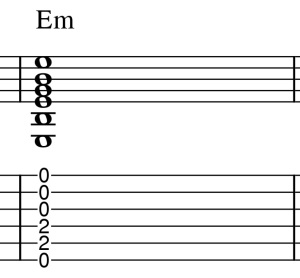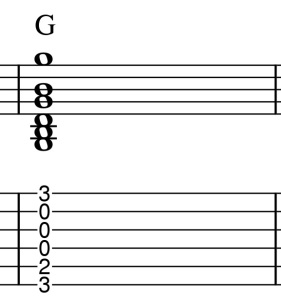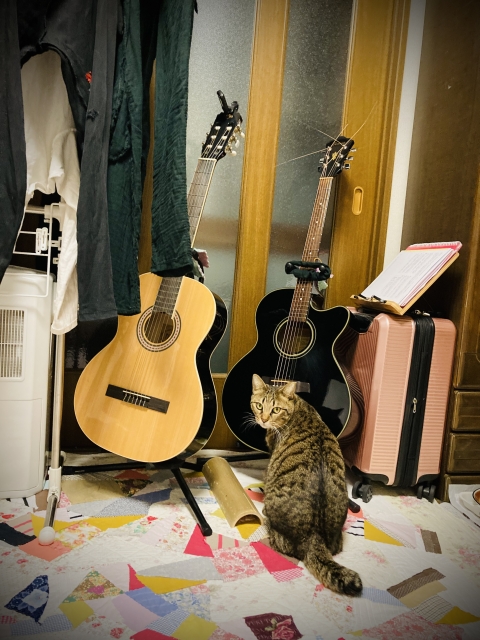In Part 5, we will take up Em and Am, G and B7 as examples of minor chord progressions.
Em has already been introduced in Part 2, Am in Parts 3 and 4, and G in Parts 2 to 4, so essentially you only need to memorize B7.
The relationship between Em and G is G = major key Em = minor key. In staff notation, the key has a # (sharp) in the F position.

If you want to enlarge the image, if you are using a computer
⇒ Open the image in a new tab
For smartphones
⇒ Swipe
What is the relationship between Em and G?
The relationship between Em and G is the same as that between C and Am.
Em=minor
In staff notation, the key has a # (sharp) in the F position.

If you want to enlarge the image, if you are using a computer
⇒ Open the image in a new tab
For smartphones
⇒ Swipe
Em (E minor) uses only two fingers
Em (E minor) uses only two fingers.
All that’s left is to play the open string, so even those who have never played the guitar can play this chord.

5th string 2nd fret ⇒ middle finger
4th string 2nd fret ⇒ Ring finger
3rd string open
2nd string open
1st string open
Am (A minor)

5th string open
4th string 2nd fret ⇒ middle finger
3rd string 2nd fret ⇒ Ring finger
2nd string 1st fret ⇒ index finger
1st string open
There are two ways to play the “G” low chord
Pattern ①

5th string 2nd fret ⇒ index finger
4th string open
3rd string open
2nd string 3rd fret ⇒ Ring finger
1st string 3rd fret ⇒ little finger
Pattern ②

5th string 2nd fret ⇒ middle finger
4th string open
3rd string open
2nd string open
1st string 3rd fret ⇒ little finger
B7 (B Seven)
B7 is a chord that includes the B chord (C, D#, F#) and the 7th A (A) note.

4th string 1st fret ⇒ index finger
3rd string 2nd fret ⇒ Ring finger
2nd string open
1st string 2nd fret ⇒ little finger
The trick is to make sure each finger doesn’t touch the string next to it.
The nuance is something like “hold your fingers straight up.”
However, due to the structure of the human body, it may be impossible to actually hold all fingers in an upright position.
Therefore, it is just a “feel” that you can straight up your finger on.
It’s starting to sound like a psychological theory…
Summary
So far, you have memorized nine chords: G, Em, C, D, Am, Dm7, Dm, E, and B7.
In the next part 6, let’s review the chords introduced so far and try playing a song with a simple chord progression.
Thank you for reading to the end.
All the music scores on this site were created by myself using Muse Score.
Unauthorized reproduction of sheet music and articles is prohibited.
Image source: photo AC
https://www.photo-ac.com/
To listen to the song, click “Cat Guitar Channel”.
Performance information is Cat Guitar Channel Performance Information Please check.


